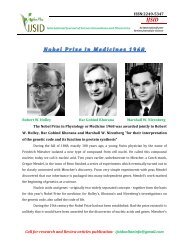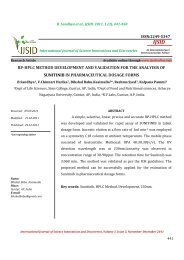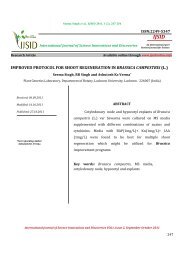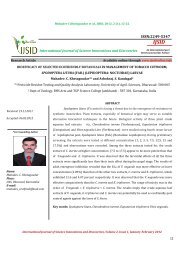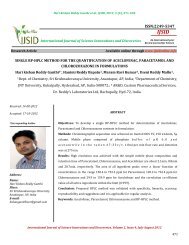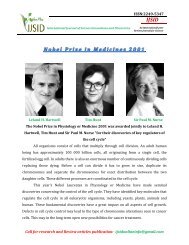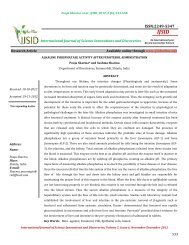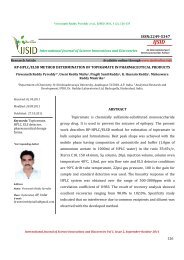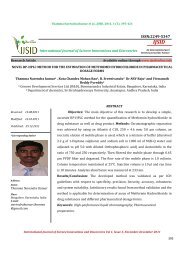(GORO) Abubakar Ahmed - Ijsidonline.info
(GORO) Abubakar Ahmed - Ijsidonline.info
(GORO) Abubakar Ahmed - Ijsidonline.info
Create successful ePaper yourself
Turn your PDF publications into a flip-book with our unique Google optimized e-Paper software.
<strong>Abubakar</strong> <strong>Ahmed</strong> Hamidu et al., IJSID, 2012, 2 (1), 61-66ISSN:2249-5347IJSIDInternational Journal of Science Innovations and DiscoveriesAn International peerReview Journal for ScienceResearch ArticleAvailable online through www.ijsidonline.<strong>info</strong>DETERMINATION OF FLAVONOIDS AND GLYCOSIDE FROM THE BARK AND LEAVES OF COLA NITIDA (<strong>GORO</strong>)<strong>Abubakar</strong> <strong>Ahmed</strong> Hamidu*, Harami m. Adamu and Kwanye DayoChemistry Department, Adamawa State University, Mubi, NigeriaReceived: 29.11.2011Accepted: 10.02.2012ABSTRACTPhytochemical analysis was carried out on the plant Cola nitida (<strong>GORO</strong>)for the presence of flavonoids and polyphenols. The plant Cola nitida belongs tothe family Sterculiaceae from which the fruits are commonly eaten among all*Corresponding Authorsection of people in Nigeria. 50 g of the dried powder of the fruit was extractedusing acetone, methanol and water sequentially. Phytochemical screening of theextracts reveals the presence of flavonoids, glycosides and polyphenols except thewater extract that shows the absence of flavonoids, glycosides and polyphenols.Thin layer chromatography was used to detect the number of components fromthe extracts for the acetone and methanol extracts showed three components ineach. The R f values are 0.62, .55 and 0.87for acetone and R f values of 0.53, 0.8, 0.5Address:and 0.83 for methanol extract.Key Words: Flavonoids, INTRODUCTION Glycosides, Phytochemical screening and R f values.Name:<strong>Abubakar</strong> <strong>Ahmed</strong> hamiduPlace:Adsu Mubi, Adamawa State,NigeriaE-mail:abshat533@yahoo.comINTRODUCTIONInternational Journal of Science Innovations and Discoveries, Volume 2, Issue 1, January-February 201261
<strong>Abubakar</strong> <strong>Ahmed</strong> Hamidu et al., IJSID, 2012, 2 (1), 61-66concentrated hydrochloride acid, acetone and petroleum ether. Other materials used included laboratory apparatus,chromatographic tank and distilled water.MethodsThe samples were dried under room temperature and grounded to powder for further analysis. The method of coldextraction was adopted for this investigation.(A) Solution Preparations(i) Preparation of IRON II CHLORIDE solution (FeCl 3)In this preparation, 5 grams of FeCl 3 was weighed and dissolved in 100cm 3 volumetric flask. This was then made tomark and allowed to cool for 30 minutes.(ii) Preparation of 10% Potassium SolutionIn this preparation, 10 grammes of potassium hydroxide (KOH) was weighed and dissolved in 100cm 3 volumetricflask. The solution was vigorously shaken until the pellets dissolved completely. This was made to mark.(iii) Preparation of 10g Sodium Hydrocide SolutionTo achieve this, 10 grammes of NaOH was weighed and dissolved in 100cm 3 volumetric flask. This was vigorouslyshaken until all the pellets dissolved completely and was made to mark using distilled water.(B) Extraction ProcedureUsing the method of cold extraction as earlier mentioned, the two different plant materials i.e. the back and leaveswere grounded to powder form, 50 grammes of each of the plant materials i.e. back and leaves was weighed separately. Thesewere then separately soaked in a round bottom flask using acetone as the solvent. The conical flask was sealed and kept for aperiod of 48 hours i.e. approximately two days. The soaking was to allow the flavonoids to be absorbed by the solvent. After aperiod of 48 hours, the soaked sample was shaken and filtered into a 250ml beaker using Whatman filter paper 1. The filtratewas dried in an Air Oven. Further extraction was also done on the plant materials i.e. back and leaves using methanol andwater as solvents. The same procedure as above was followed in each case. The procedure of extraction was repeated for atleast three times in each case.(C) Photochemical Screening of Plant ExtractPlant material extracts from the back and leaves were obtained with acetone, methanol and water respectively. Thesewere all evaluated for the presence of the following below: -i. Flavonoidii. Phenolicsiii. Flavoneiv. Phenolv. Saponinsvi. Glycosides(D) Preparation of ExtractThe preparation of the plant material extract was done by weighing 0.5grammes of the solid extract. This weight wasthen dissolved in 5ml distilled which was used for the phytochemical screening tests.International Journal of Science Innovations and Discoveries, Volume 2, Issue 1, January-February 201263
<strong>Abubakar</strong> <strong>Ahmed</strong> Hamidu et al., IJSID, 2012, 2 (1), 61-66(i) Test for Flavonoids1ml of the already prepared 10% NaOH was added to 1ml of the extract gradually and then in excess of NaOHsolution. A yellow colourations confirms the presence of flavonoids.(ii) Test for FlavoneIn this test, 5mls of the dissolved extract was taken. To this, some pieces of magnesium chips were added followed byadding concentrated hydrochloride acid drop wise. A vigorous reaction was observed with the generation of heat. A deep redcolour was also observed. This confirms the presence of flavones in the both the back and leaves of cola.(iii) Test for Glycosides5mls of H 2So 4 was heated water bath for 15 minutes. To this 5mls of Fehling’s solution was added and the mixture wasfurther heated. A brick red precipitate confirmed the presence of Glycosides.(iv) Test for PhenolsAn equal volume of the extract was added to equal volume of ferric chloride, a deep blush green colour confirmed thepresence of phenols.(v) Test for Phenolics5mls of the dissolved was taken in this case. To this, a few drops of ferric chloride was added. A yellow colourationconfirmed the presence of phenolics.(vi) Test for Saponins5mls of the dissolved plant extracted i.e. plant and leaves was vigorously shaken with 10mls of distilled water in atest-tube. The frothing which persisted was taken as confirmatory test for the presence of saponins.(E) Thin Layer ChromatographyThis technique was adopted for quantitative analysis of both sugar and non-sugar moieties in the back and leaves ofthe cola natida.The solvent system used was chloroform, methanol and water in the ratios of 35.5: 13.5: and 18 respectively. Theextracts were spotted on the chromatographic plates already prepared and left to stand for 2 hours. This shuns relativemovement of the distance between the centre spot and sample application to the distance between the solvent fronts. This wastaken as RF values.(F) Preparation of Slurry6 grammes of silica gel was weighed with 2 grammes of starch powder i.e. 6:2 ratio slurry paste was made. This wasmixed with 12mls of distilled water to arrive at 1:2 ratio. This was well shaken to achieve homogenization.(G) Slurry ApplicationTwo chromatographic plates measuring 20cm by 20cm were cleaned with distilled water and then acetone. This wasthen dried in an air oven. The slurry was spread uniformly on the plates and fused in an oven.RESULTS AND DISCUSSIONTable 1 shows the result of Phytochemical screening of the extracts of cola natida. (Bark and Leaves).QUALITATIVE ANALYSISBelow are results of chromo + thin layer chromatography of the extracts i.e leave and bark of cola natida for Glyconeand AGLYCON. The TLC calculations for glycoside obtained in the extract as follows. Six spots were developed and Rf valuescalculated as follows: Table IIInternational Journal of Science Innovations and Discoveries, Volume 2, Issue 1, January-February 201264
<strong>Abubakar</strong> <strong>Ahmed</strong> Hamidu et al., IJSID, 2012, 2 (1), 61-66= 0.62= 0.55EXTRACTSCHEMICAL CONSTITUENTSFLAVONOIDSPhenolics Flavones Saponins Glycosides PhenolA+acetone + + + + +B+acetone + + + + +A+methanol - - + + +B+methanol + + + + +A+water + + + + +B+water + + + - -KEY: A = Bark; B = Leave= 0.87TLC chromatogram of the hydrolysed extract (examination of aglycon) results as follows. Table III= 0.83= 0.8= 0.75= 0.83DISCUSSIONThe results of phytochemical screening of the plant extracts are shown in Table 1. In the table 1, phenolics, flavones,saponines, glycosides, and phenols were all present in the plant material i.e bark and leaves respectively. Except for waterwhich showed no presence of glycoside and phenols. Likewise the methanolic extract of the back of the plant material testednegative in terms of phenolics and flavones. This may be attributed to the fact that flavonoids are more available in the upperpart of the plants than the lower part (Harmanada, 1994). The results of test for sugar constituents’ glycon reveal sixintermingling spots showing three district spots. From the Table II, it can be seen that there are three aglycon present.Likewise, the results of non-sugar aglycon were shown in Table III. These results showed four spots with Rf values active forthe four spots.SUMMARYPhytochemical studies on the plant cola natida revealed the presence of flavonoids namely: phenol, saponins, flavonesand phenolics tested positive in almost all the extracts under consideration. Further qualitative studies showed the presenceInternational Journal of Science Innovations and Discoveries, Volume 2, Issue 1, January-February 201265
<strong>Abubakar</strong> <strong>Ahmed</strong> Hamidu et al., IJSID, 2012, 2 (1), 61-66of three major sugar constituents (glycosides) and four spots of for aglycons or non-sugar constituents. Further studies can beconducted to determine the activity of the various extracts.RECOMMENDATIONGoro can be consumed at a reasonable rate, and structural elucidation studies via instrumental analysis such as IR, UVand inductively coupled plasma are recommendable.REFERENCES1. Fabian, J. W (1989), the Pharmacology of Phenolics. Pp. 68 – 77. Academic Press, Newyork2. Finar, I. L (1982). The Hydrolysis of Glycoside. Fifth Edition, ELBS. Pp 769 – 7933. Harmanada, J. S. (1994). Medicinal Uses of Flavonoid Compounds, Analchem Pp. 23 – 284. Khan, I. Z, Mohammed Aquil, Kolo, B. G. (2001), New Flavone Gl;ycoside5. Katherine, K. (2001). Encyclopedia of Alternative Medicine6. Odebiyi and Safowara, A. E. (1978). Phytochemical Screening of Nigerian Medical Plants, Loydia 4.1.3. ChemicalSociety. 234 – 246.International Journal of Science Innovations and Discoveries, Volume 2, Issue 1, January-February 201266



